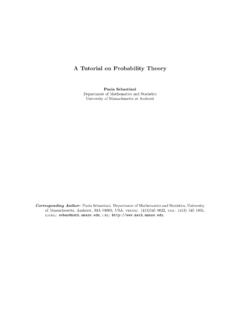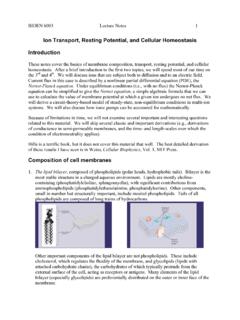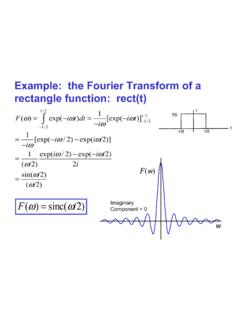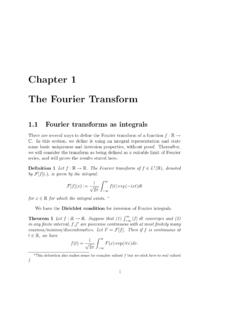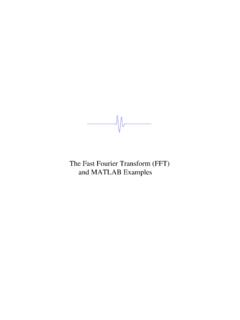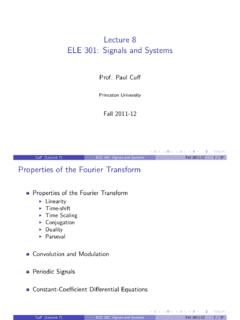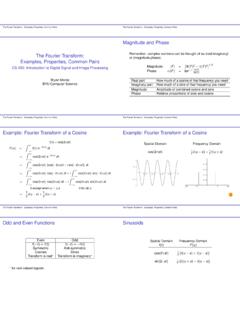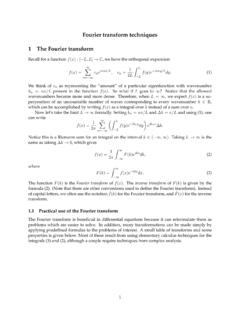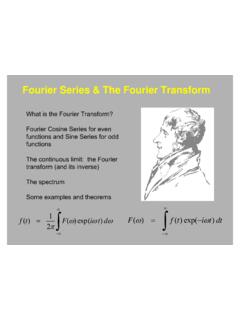Transcription of Fourier Transform in Image Processing
1 Fourier Transform inImage ProcessingCS/BIOEN 6640 U of UtahGuido Gerig(slides modified fromMarcel Prastawa 2012)Basis Decomposition Write a function as a weighted sum of basis functions What is a good set of basis functions? How do you determine the weights?)()(xBwxfii Sine Waves Use sine waves of different frequencies as basis functions?Limitation of Sines Sines are odd / anti-symmetric: Sine basis cannot create even functions:Limitation of Cosines Cosines are even / symmetric functions: Cosine basis cannot create odd functions:Combine Cosines and Sines Allow creation of both even and odd functions with different combinations:OddEvenWhy Sines and Cosines?
2 Represent functions as a combination of basis with different frequenciesWhy Sines and Cosines? Represent functions as a combination of basis with different frequencies Intuitive description of signals / images: how much high frequency content? what do the low freq. content look like?Why Sines and Cosines? Represent functions as a combination of basis with different frequencies Intuitive description of signals / images: how much high frequency content? what do the low freq. content look like? Image Processing language : remove noise by reducing high freq content explains sampling / perception phenomena Jean Baptiste Joseph FourierBasic contributions 1807: Fourier Series: Represent any periodic function as a weighted combination of sine and cosines of different frequencies.
3 Fourier Transform : Even non-periodic functions with finite area: Integral of weighted sine and cosine functions. Functions (signals) can be completely reconstructed from the Fourier domain without loosing any Fourier TransformReminder: Euler s Identity From calculus jis the imaginary part of a complex numberxjxesincos jxFourier Transform Forward, mapping to frequency domain: Backward, inverse mapping to time domain:+Space and FrequencyFourier Series Projection or change of basis Coordinates (coeffs) in Fourier basis: Rewrite f as:1 Fourier Series: f(t) F(s)source: Series.
4 ApproximationVisualisation of an approximation of a square wave by taking the first 1, 2, 3 and 4 terms of its Fourier seriesVisualisation of an approximation of a sawtooth wave of the same amplitude and frequency for comparisonSource: Basis Why Fourier basis? Can represent integrable functions with finite support (J P Fourier 1807) Also Orthonormal in [-pi, pi] Periodic signals with different frequencies Continuous, differentiable : Cos(x), Cos(2x), Cos(x)*Cos(2x) cos cos 0 2 Fourier Transform Forward, mapping to frequency domain: Backward, inverse mapping to time domain:+Sifting Property See text book DIP Transform PairsDirac delta - constantDigital Image Processing , 3rd Image Processing , 3rd 1992 2008 R.
5 C. Gonzalez & R. E. WoodsGonzalez & WoodsChapter 4 Filtering in the Frequency DomainChapter 4 Filtering in the Frequency DomainCommon Transform PairsRectangle sincsinc(x) = sin(x) / xCommon Transform PairsCosine - Two symmetric DiracsCommon Transform PairsGaussian Gaussian (inverse variance)Common Transform PairsComb comb (inverse width)QuizWhat is the FT of a triangle function?Hint: how do you get triangle function from the functions shown so far?AnswerTriangle = box convolved with boxSo its FT is sinc * sincQuiz What is the FT? Hint: use FT properties and express as functions with known transforms Answerf(x) = (x/4) (x/2) +.
6 5 (x)FT is linear, soF(s) = 4sinc(4s) - 2sinc2(2s) + .5sinc2(s) Fourier TransformF(s) = 4sinc(4s) - 2sinc2(2s) + .5sinc2(s)F(s)InverseFourierf(x)Cut-off High Frequenciesf(x)F(s)InverseFourierF(s) = (4sinc(4s) - 2sinc2(2s) + .5sinc2(s))*(HeavisidePi(w/8)1D: Common Transform Pairs SummarysourceFT Properties: Convolution See book DIP : Convolution in space/time domain is equiv. to multiplication in frequency ApplicationFiltering in frequency DomainFT Properties)




